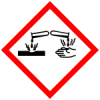Coalition status
Fairtrade Red
This list contains 207 pesticides. The list is valid as of January 2018.
Prohibited pesticides that must not be used on Fairtrade products under any…
Rainforest prohibited PesticidesRSB BanNone of the chemicals recorded in the WHO’s 1a and 1b lists shall be used. The use of chemicals recorded in Annex III of the Rotterdam Convention, in…
SAN HHP: phase-outThe SAN List of Highly Hazardous Pesticides consists of 230 pesticides:
SAN HHP Pesticides are classified as Highly Hazardous Pesticides according to…
UEBT ProhibitedThe use of Prohibited Agrochemicals is prohibited for certified, prioritised and verified ingredients, because they are considered Highly Hazardous…
Details
Type: Obsolete pesticide
Use: Fungicide
Example applications: Cereals;Legumes;Root crops
Example pests controlled: Ustilago scitaminea;Rhizobium solani;Fusarium spp.
Mode of action: Acts by reacting with the sulfydryl group in fungal pathogens and inhibits growth
Source: PPDB
Toxicty
GHS safety labels
About Globally Harmonized System of Classification and Labelling of Chemicals (GHS)
From Wikipedia: The Globally Harmonized System of Classification and Labelling of Chemicals (GHS) is an internationally agreed-upon standard managed by the United Nations that was set up to replace the assortment of hazardous material classification and labelling schemes previously used around the world. Core elements of the GHS include standardized hazard testing criteria, universal warning pictograms, and harmonized safety data sheets which provide users of dangerous goods with a host of information. The system acts as a complement to the UN Numbered system of regulated hazardous material transport. Implementation is managed through the UN Secretariat. Although adoption has taken time, as of 2017, the system has been enacted to significant extents in most major countries of the world.[1] This includes the European Union, which has implemented the United Nations' GHS into EU law as the CLP Regulation, and United States Occupational Safety and Health Administration standards.
- H301

Toxic if swallowed
Class: Acute Toxicity
Subclass: Oral - H314

Causes severe skin burns and eye damage
Class: Corrosion/irritation
Subclass: Skin - H372

Causes damage to organs (state all organs affected, if known) through prolonged or repeated exposure (state route of exposure if it is conclusively proven that no other routes of exposure cause the hazard)
Class: STOT
Subclass: Repeated exposure - H400

Very toxic to aquatic life
Class: Aquatic
Subclass: Acute - H410

Very toxic to aquatic life with long lasting effects
Class: Aquatic
Subclass: Chronic
